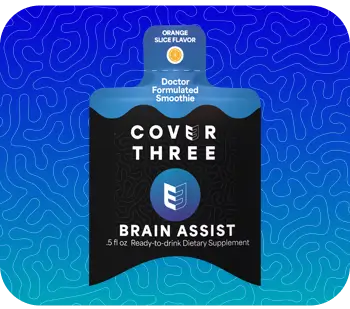What Dosage of Omega-3 Fatty Acids Is Recommended for Children?
The following table shows the adequate daily intakes of omega-3 oils in the pediatric population, as recommended by the National Institutes of Health (NIH):
A brain-healthy diet lets you compete at the highest levels in any field.

*As total omega-3 fats
**As ALA. About 15-20% of ALA is converted to other omega-3 fatty acids.
***Increases to 1.4 g during pregnancy and 1.3 g during lactation
This table mostly refers to ALA as the primary omega-3 fatty acid source. However, only 15-20% of it is converted to DHA, the brain's predominant fatty component, and EPA, the body's protector from inflammation. Optimum development requires more DHA and EPA than what dietary ALA can produce.
How do you know if your child is taking enough omega-3 fatty acids?
Take note of the foods they eat, look up their omega-3 fatty acid content on the USDA's FoodData Central page and add up the numbers. You may compare them with what the above table recommends as the minimum for their age and gender.
However, optimum growth requires more, and the FDA states that children can have as much as 3.0 g of total daily omega-3s, including DHA and EPA. Additionally, you must make room for illnesses because they also deplete the body's stores of these nutrients. The risk of developing omega-3 fatty acid deficiency should concern you because the condition is damaging to children's health.
The standard American diet includes foods rich in simple sugars, as well as flavor enhancers filled with saturated and trans fats. And when kids look at their friends and people on TV taking pleasure in eating such foods, it's easy to understand why they would be tempted to do the same and pass up on your salmon casserole.
However, these edibles are low on omega-3s. Omega-3 fatty acid insufficiency leads to dermatologic problems, poor cardiovascular function, chronic inflammation, behavioral issues, learning difficulties and the inability to concentrate. These complications can impair children's development and wreck their future.
If your kid is on this dangerous path, you might think of forcing them to eat healthy. However, parent-child conflict, even over small matters like food, can traumatize growing kids. Doctor-formulated Cover Three Kids Brain Boost was made to address this problem.
Similarly, Brain Assist can support parents focused on becoming the best parents they can be by giving them a complete brain-boosting nutrient combination.
“With the blend of turmeric and omega fatty acids in Cover Three, I felt amazing. And I've tried a lot of nootropics and with Cover Three I definitely experienced better brain function”
Dr. Amber Krogsrud
Naturopathic

|
Omega-3 fatty acids are substances that have structural and functional significance in the body. They are essential nutrients—human cells cannot make omega-3s on their own and must obtain them from the diet. |
First Things First — What Are Omega-3 Fatty Acids?Omega-3 fatty acids belong to a class of compounds called "polyunsaturated fatty acids" or PUFAs. These substances have multiple unsaturated bonds, or "double bonds,” that let them remain fluid at normal temperatures—a property that is crucial to cellular function. 
Omega-3 fatty acids are named after the omega-3 unsaturated bond. Three omega-3 oils are important to humans: docosahexaenoic acid (DHA), eicosapentaenoic acid (EPA) and alpha-linolenic acid (ALA). DHA EPA ALA  Omega-3 Fatty Acids That Are Important to Human Growth Flaxseed oil, chia seeds and walnuts are abundant sources of ALA. On the other hand, DHA and EPA are best obtained from fatty fish. Lactating mothers on omega-3-rich diets have higher amounts of these nutrients in their milk, which is good for exclusively breastfed infants.
How is this information relevant to your child’s health? “We need these(Alpha GPC and DHA omegas) in our children. We need these during pregnancy. We need these before pregnancy. Moms who are breast-feeding need to be taking these nutrients. Babies need to be taking these nutrients.” Dr. Ari Calhoun |
What Are the Roles of Omega-3 Fatty Acids in a Child's Body?Omega-3 fatty acids have crucial functions in a child's body. The most important ones are explained below.  The Brain Cells Interacting at Lightning Speed at the Synapse In the brain, neuronal communication is a fast process. Children's reflexes, memory retrieval, multiplication skills, emotional regulation and other mental tasks depend on the signaling between different brain cells. Omega-3 fatty acids, mostly DHA, keep the brain cell membranes fluid to ensure that message transmission occurs within a split-second.
Omega-3 derivatives have actions different from those of their omega-6 counterparts. The former combat inflammation while the latter promote the process. Both groups of molecules are needed for normal function. However, a higher intake of omega-6 fatty acids, typical of the standard American diet, can make kids susceptible to frequent bouts of inflammation.
Keeping Bad Cholesterol in Check Cholesterol plaques are collections of excess cholesterol—another type of fat molecule—and debris that build up in the blood vessels over time. Plaque formation begins as early as childhood, and it can speed up or slow down, depending on one's diet and genetic factors. |
|
“Cover Three helped to make everything more connected in the memory center of the brain” Michael Edwards
|
What Are the Benefits of Omega-3 Fatty Acids for Kids?Healthy kids grow up to become intellectually, emotionally and physically resilient adults. Omega-3 fatty acids support children's health, letting them become bold conquerors of life's challenges. Various studies prove the beneficial actions of these essential nutrients. Cognition: Sleep and IQ: Mood regulation: ADHD Symptoms: Self-esteem:
Enhanced Cardiovascular Function Omega-3 fatty acid levels inversely correlate with obesity and insulin resistance among school-age children. In one study, the intake of omega-3 fatty acid supplements led to total blood cholesterol reduction among overweight school-age girls. It also resulted in better blood pressure control among overweight school-age boys. In a study involving young kids at risk of undernutrition, the intake of omega-3 supplements increased blood flow to the brain, resulting in cognitive enhancement. Modulation of Inflammatory Responses In a group of school-age children, higher omega-3 fatty acid intake was associated with fewer allergic reactions and a lesser need for bronchodilator therapy. Increased omega-6 fatty acid intake was associated with opposing trends. Various studies show that young women with haywire immunity experience relief. In a group of young people with digestive problems, the Mediterranean diet, a regimen requiring high seafood intake, was associated with nutritional improvement. Studies show that omega-3 fatty acids may retard the development of nerve tissue abnormalities in the young. Chronic inflammation wears people out, and its health risks are real no matter what age. Omega-3 fatty acids modulate kids’ inflammatory responses, keeping them on track to meet their goals.
|
What Are the Side Effects of Omega-3 Fatty Acids?Some of the known side effects of Omega-3 fatty acids are:
Blood clotting is a process that depends on the balance between clotting promoters and suppressors. Blood will clot if the promoters predominate, but it will stay fluid if the suppressors prevail. Blood that is too thick or clots easily can clog the vessels and deprive the cells of oxygen. On the other hand, blood thinning can also weaken the blood vessels. Omega-3 fatty acids are needed to keep this balance. When taken in the recommended amounts, the risk of bleeding is insignificant. Studies among adult patients taking omega-3 oil supplements are inconclusive at best. Remember that some of them are even taking blood thinners for chronic health conditions. Another research showed thatfish oil supplementation did not increase the occurrence of bleeding among at-risk children. The FDA recommends that the total daily omega-3 fatty acid intake should not exceed 3.0 g, and as much as 2.0 g can come from supplements. However, according to the European Food Safety Authority, the consumption of 5.0 g of combined omega-3 oils daily has not been associated with adverse effects in healthy children or adults. |
How Can You Get Your Kids to Take Omega-3 Fatty Acids?
Now that you know more about the benefits and safety of omega-3s, your next concern may be about how to give them to picky eaters.
However, we all know that the struggle is harder with some kids. You may try giving them fish oil, but it is known for its funny smell and taste and tendency to cause allergies. Chewable gel capsules are another option, but some kids don't think they're fun. |
|
Last but not the least, you may try doctor-formulated Cover Three Kids Brain Boost. It has that yummy orange taste that kids love. Besides being loaded with omega-3 fatty acids, it is packed with other brain boosters to improve your child's mental and physical performance.  Alpha-glycerophosphocholine boosts alertness, memory and focus. It also helps power up muscle movement.  Curcumin sharpens memory and focus while keeping the mood up and protecting from inflammation.  Trans-resveratrol isa powerful free radical neutralizer, protecting the brain and body from stress.  Uridine aids brain cell development, body growth and immune function.  Vitamin C powers up the immune system while enhancing mental focus.
|
ConclusionOmega-3 fatty acids are essential nutrients that help build cell membranes, boost mental performance, fight inflammation and ensure cardiovascular health. They are obtained mostly from the diet, and rich sources include fatty fish, nuts, seeds and fortified milk. They are generally safe for children when given at the right amounts. However, picky eaters and chronically sick kids are at risk of developing omega-3 fatty acid deficiency. Cover Three Kids Brain Boost is a yummy supplement that can ensure that your child is getting enough omega-3s to support their full development. It also has other mental focus boosters that can help them build mental momentum and secure a brighter tomorrow. |







